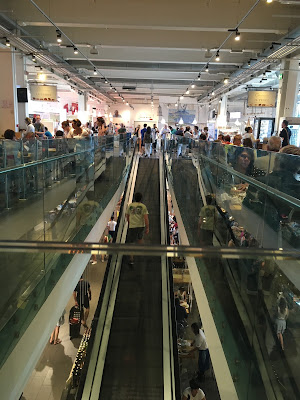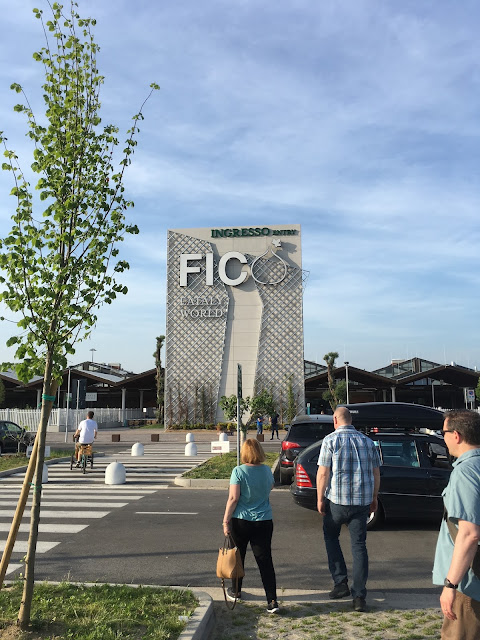A lot of people persist in thinking that I live some kind of ultra-charmed life here, and I want to just share a slice of how charming it can be.
Yesterday, I met my class at Santa Maria Maggiore.
The first church dedicated to Mary....unless you say this in front of fans of Santa Maria in Trastevere, in which case you have to concede that TWO churches vie for this position.
Well, I met a percentage of my class. Four people were absent.
I would not mind this so much if it did not also mean that I would be responsible for delivering three of those four students' presentations on assigned objects for the day's itinerary. It seems like a great idea to have students take on responsibility for a portion of a day's course content - even if only superficially - by requiring that they be prepared in advance of said course...unless they don't. No messages, no apologies, no word at all...just no-shows.
From the before times, when people were taking notes (sure, on their phones, but so what?) and not missing scheduled presentations)
After we got through our itinerary, I walked to Rome's main rail station to renew my recently expired transit pass.
As I entered the station, I recalled the reviews I'd recently read about the Rome transit office (they just come up when you seek out directions on Google maps). People angrily complaining about the extreme difficulty of finding the office within the rail station. Cursing the terrible service. Bitter about the lack of clear information. I felt pretty confident that I would be less angry after I went through this because I've done it a few times before.
After 5 years of being here and having them confirmed in an extraordinary number of ways I never imagined possible, I must verify that there are two realities that you have to accept about this place: Italy does not - and as far as we can all tell, will NEVER - care about customer service, and Italians are very much in favor of being first - in line, to board the bus, to get the taxi, to get whatever meager service is possibly on offer.
These two realities combine perfectly in the case of the working Italian's lunch hour.
After easily losing 30 minutes to a trek to find a bathroom in the train station (sure there are signs, but they don't continue to appear frequently enough to actually get you to a bathroom), standing in line to first pay 1 euro to use the bathroom and then wait with all of the other women to access what appeared to be four working stalls (out of a total of 7), giving silent thanks for stocked toilet paper and a lock on the door (it's the little things, when you consider the nationwide state of Italian restrooms), and then trying and failing to retrace my steps to get back to where I thought I saw a sign for the transit office. I covered every inch of that place. Where the heck is it? Oh. Two levels down into the belly of the train station and behold, there it was.
A line consisting of about 15 people was in place. The three windows for service were in operation. Much like other Italian businesses that have become fed up with people jumping the line and causing a commotion, this office has a machine that generates a number on a ticket for you. This is intended to keep people honest about where they are in the queue.
But the transit office's machine is broken. This should come as zero shock to any former visitor or resident.
It is about 1pm. Blinds on window #3 are lowered, leaving us with only two functioning windows.
There is no prioritization of service, by the way. There is no fast lane or dedicated window for people who have quick business vs. more involved needs. You need to buy one single ride bus ticket? You need to obtain a student bus pass for the 6 months that you are here? Great. Everybody stands in the same line, and they go to whatever window is free.
I should add that when I first arrived, I did see a man in a transit company uniform, standing behind a kind of mobile kiosk with this poorly hand-written sign in thin black marker, informing customers in Italian that they could go down the hall (where exactly, I couldn't tell you if you paid me) to obtain single tickets. He wasn't talking to or greeting anyone. He just stood there. No one talked to him. But about 15 minutes later, he rolled the little kiosk up against far wall and left.
By the time I am second in line behind a couple, there are about 25-30 people in the line after me, sitting on their suitcases, staring at their phones, seething.
And the blinds are then lowered on window #2, leaving us all to wait for service from one remaining window.
You might be wondering why no one would come to relieve someone for their lunch hour but still maintain a degree of service for all the people in line.
Oh sure, I saw that happen. Once. But this was for the single remaining window operator. Nothing was done to open up the two shuttered windows.
The bottom line: if you come to the transit office for service during the widely observed lunch hour - perhaps during YOUR lunch hour - you are going to endure this.
While the process of renewing my transit card was admittedly painless, the rest of my afternoon would not be.
I have two arthritic knees. I would prefer to use an escalator to go UP. Contrary to my usual experience in Italy, the escalators I find are actually working.
But for some colossally stupid reason, they are - all FOUR OF THEM (I checked, in disbelief) - running in the downward trajectory.
Now, let's consider that this main rail station has a lot of travelers in it. Travelers with suitcases, baby carriages, and whatnot. What's easier to do: manipulate your cargo down - or up - a flight of stairs? This is what I mean when I say that the Italian lack of interest in customer service can emerge in astonishing ways. Someone just turned on all the escalators to run in the same useless direction and no one will do anything about it.
It is supremely difficult to not imagine someone in an underground office somewhere, watching people on closed circuit cameras, twirling their evil mustaches as travelers struggle up the stairs with their luggage and kids.
Before I leave the next level of the station, I decide to stop by Sephora to see if I can find a particular brand of nail polish remover.
Because businesses have had to navigate the murky world of routing foot traffic through their spaces - dictated by some Byzantine method of reducing Covid transmission - there are some spectacular successes AND failures.
Imagine a long rectangle. At one end, there is a doorway. It is closest to the next set of escalators (which thankfully, are running in both up and down directions). It is roped off. You cannot use it.
You must walk all the way around the long rectangle to get to the other end, where you find an arrow on the floor directing you inside, and another arrow pointing in the opposite direction, approximately 5 feet away, but using the same wide door. This is not what Covid guidelines ever intended for a business to do with its foot traffic. This is not a unilaterally safe means of routing people through your shop.
After wandering and wandering (there were approximately 8 black-garbed staff aimlessly milling about, heads clustered together in conversation or, predictably, furtively looking at their phones, but unlike any American version of this store - in which you must grimly fend off the syrupy 'Hi! What can I help you find today?' "Do you need a shopping basket?' "Has anyone assisted you yet?' queries that come as a never-ending onslaught, only one INSTRUCTED me to use the hand sanitizer at the entrance and I was subsequently left completely alone), I realized that not only was there zero nail polish being sold from that shop, there was zero nail polish remover. I stopped at the samples aisle, which as many of you know is directly located by the cash registers....which are directly beside the doorway that no one is allowed to use. And I realized what else was so wrong with this arrangement.
I have to go inside the store right beside the people who are exiting the store. Mmmmm, Covid intimacy. How nice. And those people have come all the way from the other end of the store where the cash registers are, carrying their stripey Sephora bags and, what, helping themselves to merchandise on their way to the exit because they have to walk through the entire shop in order to get out, and NONE of the staff give two hoots what the customers are doing or need?
I leave empty-handed, walk to an Asian grocery store and realize that almost all of the things I intend to get are in heavy glass bottles and cans. Awesome.
I walk several blocks to a bus stop. By many (but certainly not all, because why does there have to be consistency, exactly? What's in it for Italy to have any consistency?) bus stops in Rome there is an electronic sign that regularly posts updated information on bus arrival times.
Unless it doesn't.
Instead, today, all of them (I saw it again later in the day, at another stop) simply read: Informazioni temporaneamente sospese.
I turn to my phone app, Moovit. It too is blank.
I stand there indefinitely, holding bags with heavy cans and bottles.
And it begins to rain.
I'm prepared. I have an umbrella. But my hands are full and it's hard to get it out. So I have to fend off one of those annoying street vendors who forcefully offers to sell me one of his crap umbrellas.
A bus finally arrives and I board it. The bus is full of people bundled in puffy coats and scarves. The windows on the bus are closed because Italians are terrified of cold air hitting their necks. There is no air movement.
The day's high temperature is 70 F (29 C). I might as well be a dumpling inside a bamboo steamer.
All of my friendly food vendors start to inquire after my lack of cold weather clothing at this point in the year. Aren't you cold? No jacket? Where is your coat? And I just shrug and say 'sono Americana.' I know that I talk a lot about the heat here, but it bears mentioning that when the outdoor temperatures become bearable, Italians at large find them nearly UNbearable. And meanwhile, every Covid-safety-theater temperature gun aimed at my forehead or wrist as I enter a building or office here yields the same spooky conclusion: by Italian standards, I am dead. I do not register at a normal human temperature.
NO WONDER I'VE BEEN SO MISERABLE AND DEHYDRATED.
By the time I arrive home, I am full-on sweaty, tired and over it.
I logged over 8,000 steps for this charming day.
A colleague used to say that at our particular place of work, if you were having one of those days in which it was abundantly clear that the environment is steeped in futility and you are but a cog in the wheel with virtually no control or agency, you were 'having a (name the place) moment.'
Well, dear readers, this little summary of my Roman moment might help take the shine off of your perceptions.


















































